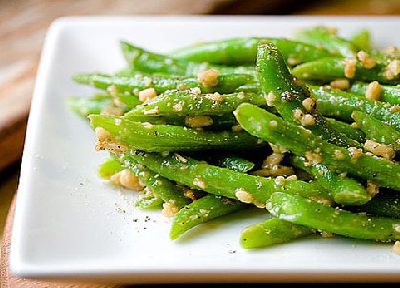Green Bean Salad

Green Bean Salad Is One Of My Favorite Salads
Green Bean Salad is a favourite salad I eat, particularly during the warmer months when the beans are growing well. Beans taste very sweet when you pick them and for best nutritional value, prepare this salad not long after you pick the beans.
While green beans are typically referred to as “string” beans, many varieties no longer actually feature the fibrous ‘string’ that runs down the length of the earlier varieties. Green beans are also commonly known as snap beans. Haricots verts are French green beans that are very thin and very tender.
Green beans are in the same family as shell beans, such as pinto beans, black beans and kidney beans. Yet unlike their cousins, green beans’ entire bean, pod and seed, can be eaten.
Green beans range in size, but they usually average four inches in length. They are usually deep emerald green in color and come to a slight point at either end. They contain tiny seeds within their thin pods.
The Salad:
Dressing:
Method
Green Beans Are Very Healthy To Eat
Vitamins A & C
Green beans contain appreciable amounts of vitamin A (beta-carotene in fact, the water soluble form of vitamin A) and along with vitamin C are an important part of a healthy immune system. Beta-carotene and vitamin A are fat-soluble antioxidants, while vitamin C functions as an antioxidant in the water-soluble areas of the body. So, between their beta-carotene and vitamin C content, green beans have all areas covered against damage from oxygen free radicals.
In addition to its antioxidant activity, vitamin C is critical for good immune function. Vitamin C stimulates white cells to fight infection, directly kills many bacteria and viruses, and regenerates vitamin E after it has been inactivated by disarming free radicals.
May help prevent bowel cancer
The vitamin C and beta-carotene in green beans help to protect the colon cells from the damaging effects of free radicals. Green beans’ folate helps to prevent DNA damage and mutations in colon cells, even when they are exposed to cancer-causing chemicals. Studies show that people who eat foods high in vitamin C, beta-carotene, and/or folate are at a much lower risk of getting colon cancer than those who don’t.
The fiber in green beans can help prevent colon cancer as well, as it has the ability to bind to cancer-causing toxins, removing them from the body before they can harm colon cells.
Cardiovascular protection
For atherosclerosis (plaque buildup in the arteries) and diabetic heart disease, few foods compare to green beans in their number of helpful nutrients. Green beans are a very good source of vitamin A, notably through their concentration of beta-carotene, and an excellent source of vitamin C.
Iron containing and energy producing
As noted above, green beans are a very good source of iron. Iron is as essential part of hemoglobin, a molecule essential to energy production since it is responsible for transporting and releasing oxygen throughout the body.
Helps build up bone tissue
The vitamin K provided by green beans is an amazing 25% of the daily value in one cup! Vitamin K is important for maintaining strong bones. Vitamin K1 helps prevent excessive activation of osteoclasts, and these are the cells responsible for breaking down bone.
